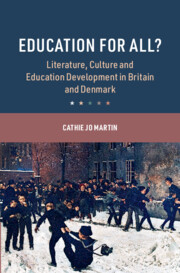Book contents
- Education for All?
- Cambridge Studies in the Comparative Politics of Education
- Education for All?
- Copyright page
- Dedication
- Contents
- Figures
- Tables
- Acknowledgments
- Note on the Text
- Introduction
- 1 Culture and the Politics of Comparative Education Policy
- 2 Culture and Continuity through Institutional Change
- 3 Romancing the Nation: Education and Nation-Building in 1800
- 4 Expanding Educational Access in the Age of Social Realism
- 5 Education in the Age of Empire, Globalization and Technological Change
- 6 Cultural Echoes of the Past in Contemporary Education Reforms
- Bibliography
- Index
5 - Education in the Age of Empire, Globalization and Technological Change
Published online by Cambridge University Press: 27 September 2023
- Education for All?
- Cambridge Studies in the Comparative Politics of Education
- Education for All?
- Copyright page
- Dedication
- Contents
- Figures
- Tables
- Acknowledgments
- Note on the Text
- Introduction
- 1 Culture and the Politics of Comparative Education Policy
- 2 Culture and Continuity through Institutional Change
- 3 Romancing the Nation: Education and Nation-Building in 1800
- 4 Expanding Educational Access in the Age of Social Realism
- 5 Education in the Age of Empire, Globalization and Technological Change
- 6 Cultural Echoes of the Past in Contemporary Education Reforms
- Bibliography
- Index
Summary
Britain’s Education Act of 1902 created a unitary secondary education system emphasizing humanistic studies, eliminated funding for vocational programs, and served only academic students. Denmark’s 1903 Grammar School Act created a system with multiple academic programs (in classics, mathematics, and modern languages) and retained ample funding for vocational, agricultural, and folk high schools. The authors contributed to the momentum for secondary education. British authors largely advocated for a classical curriculum: Rudyard Kipling linked education to nationalist imperialistic ambitions and H.G. Wells feared cultural degradation. Some, for example, Thomas Hardy, sought classical study for the working class and viewed vocational training as second-class education. Alternatively, Danish authors across the political continuum portrayed workers’ education and skills as essential to the industrial project, economic competitiveness, and the collective good. Writers joined in struggles over secondary education reform. British Fabians worked closely with Robert Morant, the architect of the 1902 secondary education act; Kipling waged a public opinion campaign linking education to the Boar War. Danish authors in the Modern Breakthrough movement formed “the Literary Left” faction to help forge the Left Party’s positions on education and fostered closer ties among evangelical farmers and workers.
Keywords
- Type
- Chapter
- Information
- Education for All?Literature, Culture and Education Development in Britain and Denmark, pp. 160 - 204Publisher: Cambridge University PressPrint publication year: 2023

